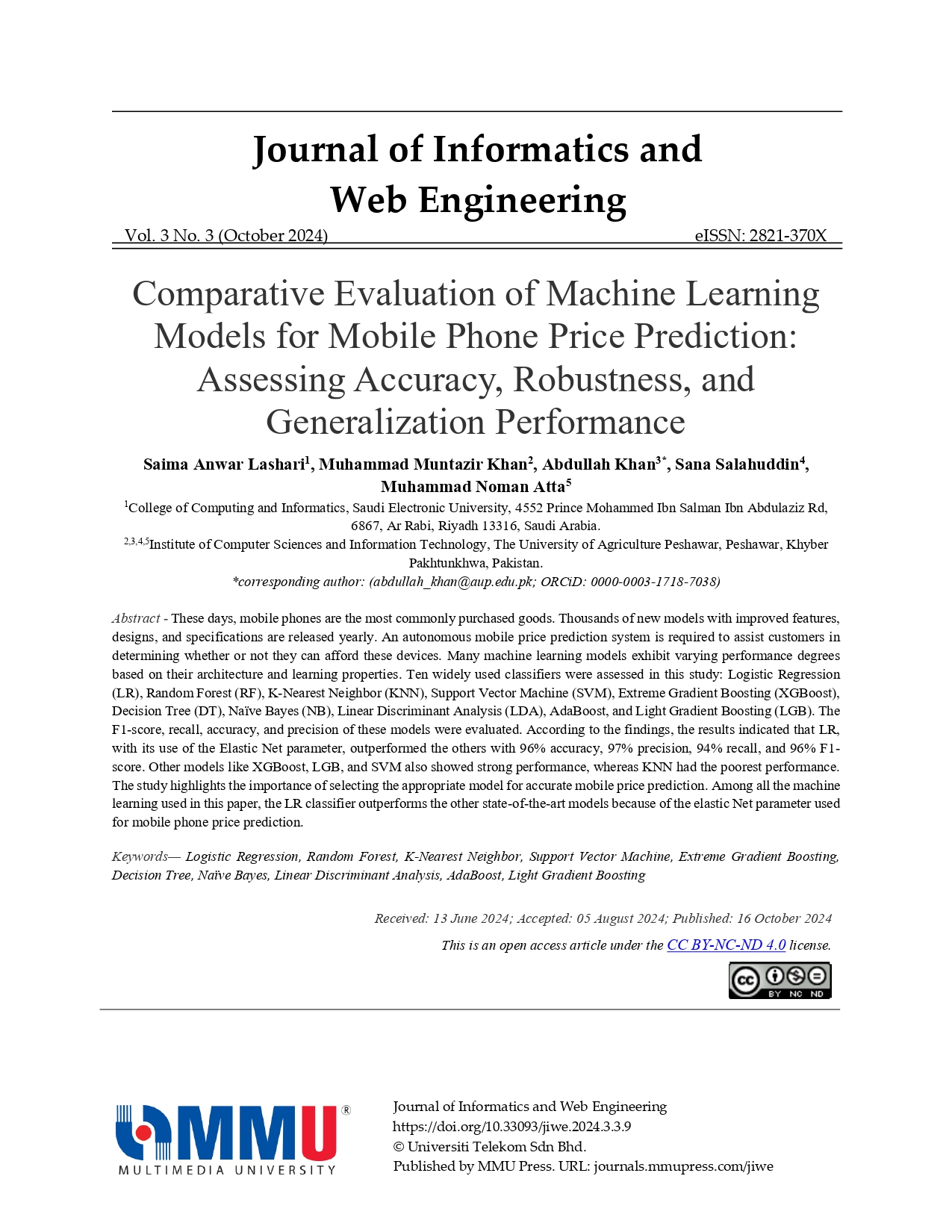Comparative Evaluation of Machine Learning Models for Mobile Phone Price Prediction: Assessing Accuracy, Robustness, and Generalization Performance
Main Article Content
Abstract
These days, mobile phones are the most commonly purchased goods. Thousands of new models with improved features, designs, and specifications are released yearly. An autonomous mobile price prediction system is required to assist customers in determining whether or not they can afford these devices. Many machine learning models exhibit varying performance degrees based on their architecture and learning properties. Ten widely used classifiers were assessed in this study: Logistic Regression (LR), Random Forest (RF), K-Nearest Neighbor (KNN), Support Vector Machine (SVM), Extreme Gradient Boosting (XGBoost), Decision Tree (DT), Naïve Bayes (NB), Linear Discriminant Analysis (LDA), AdaBoost, and Light Gradient Boosting (LGB). The F1-score, recall, accuracy, and precision of these models were evaluated. According to the findings, the results indicated that LR, with its use of the Elastic Net parameter, outperformed the others with 96% accuracy, 97% precision, 94% recall, and 96% F1-score. Other models like XGBoost, LGB, and SVM also showed strong performance, whereas KNN had the poorest performance. The study highlights the importance of selecting the appropriate model for accurate mobile price prediction. Among all the machine learning used in this paper, the LR classifier outperforms the other state-of-the-art models because of the elastic Net parameter used for mobile phone price prediction.
Article Details

This work is licensed under a Creative Commons Attribution-NonCommercial-NoDerivatives 4.0 International License.
All articles published in JIWE are licensed under a Creative Commons Attribution-NonCommercial-NoDerivatives 4.0 International (CC BY-NC-ND 4.0) License. Readers are allowed to
- Share — copy and redistribute the material in any medium or format under the following conditions:
- Attribution — You must give appropriate credit, provide a link to the license, and indicate if changes were made. You may do so in any reasonable manner, but not in any way that suggests the licensor endorses you or your use;
- NonCommercial — You may not use the material for commercial purposes;
- NoDerivatives — If you remix, transform, or build upon the material, you may not distribute the modified material.
References
Y. Chen, "Prediction of Different Types of Mobile Phone Prices based on Machine Learning Models," Highlights in Science, Engineering and Technology, vol. 92, pp. 275-279, 2024. doi: 10.54097/shgcew53.
A. Saeed, A. Mukhtar, Y. Arafat, M. Abbas, and A. Saeed, "Intelligent Assessment of Secondhand Mobile Phone Prices by Machine Learning Techniques," Journal of Computing and Biomedical Informatics (JCBI), 2024. https://jcbi.org/index.php/Main/article/view/351/262
A. V. Kiran and R. Jebakumar, "Prediction of mobile phone price class using supervised machine learning techniques," International Journal of Innovative Science, Research and Technology, vol. 7, no. 1, pp. 248-251, 2022. doi: 10.5281/zenodo.5897944.
M. Asim and Z. Khan, "Mobile price class prediction using machine learning techniques," International Journal of Computer Applications, vol. 179, no. 29, pp. 6-11, 2018. doi: 10.5120/ijca2018916555.
K. S. Kalaivani, N. Priyadharshini, S. Nivedhashri, and R. Nandhini, “Predicting the price range of mobile phones using machine learning techniques,” in AIP Conference Proceedings, vol. 2387, no. 1, p. 140010, AIP Publishing, 2021, doi: 10.1063/5.0068605.
W. Froelich and P. Hajek, “Combining rough set-based relevance and redundancy for the ranking and selection of nominal features,” Procedia Computer Science, vol. 176, pp. 1459-1468, 2020. doi: 10.1016/j.procs.2020.09.156.
N. Hemageetha and G. M. Nasira, “Radial basis function model for vegetable price prediction,” in 2013 International Conference on Pattern Recognition, Informatics and Mobile Engineering, pp. 424-428, 2013. doi: 10.1109/ICPRIME.2013.6496514.
J. Zhou, Y. Qiu, S. Zhu, D. J. Armaghani, C. Li, H. Nguyen, and S. Yagiz, “Optimization of support vector machine through the use of metaheuristic algorithms in forecasting TBM advance rate,” Engineering Applications of Artificial Intelligence, vol. 97, 104015, 2021. doi: 10.1016/j.engappai.2020.104015.
R. Costache, A. Arabameri, H. Moayedi, Q. B. Pham, M. Santosh, H. Nguyen, et al., “Flash-flood potential index estimation using fuzzy logic combined with deep learning neural network, naïve Bayes, XGBoost and classification and regression tree,” Geocarto International, vol. 37, no. 23, pp. 6780-6807, 2022. doi: 10.1080/10106049.2021.1948109.
H. A. Park, “An introduction to logistic regression: from basic concepts to interpretation with particular attention to nursing domain,” Journal of Korean Academy of Nursing, vol. 43, no. 2, pp. 154-164, 2013. doi: 10.4040/jkan.2013.43.2.154.
S. R. Gunn, “Support vector machines for classification and regression,” Technical Report, vol. 14, no. 1, pp. 5-16, 1998. https://eprints.soton.ac.uk/256459/.
M. Listiani, “Support vector regression analysis for price prediction in a car leasing application,” 2009. https://citeseerx.ist.psu.edu/document?repid=rep1&type=pdf&doi=dc68aa0a77c71592e87e5d4097a2261c224184f8.
M. Ali, F. Pervez, M.N. Atta, A. Khan, and A. Khan, “Sine Cosine Algorithm for Enhancing Convergence Rates of Artificial Neural Network: A Comparative Study”, Journal of Engineering Technology and Applied Physics, vol. 6, no. 2, pp. 34-37, 2024. doi: 10.33093/jetap.2024.6.1.3
Q. Zou, K. Qu, Y. Luo, D. Yin, Y. Ju, and H. Tang, “Predicting diabetes mellitus with machine learning techniques,” Frontiers in Genetics, vol. 9, 515, 2018. doi: 10.3389/fgene.2018.00515.

